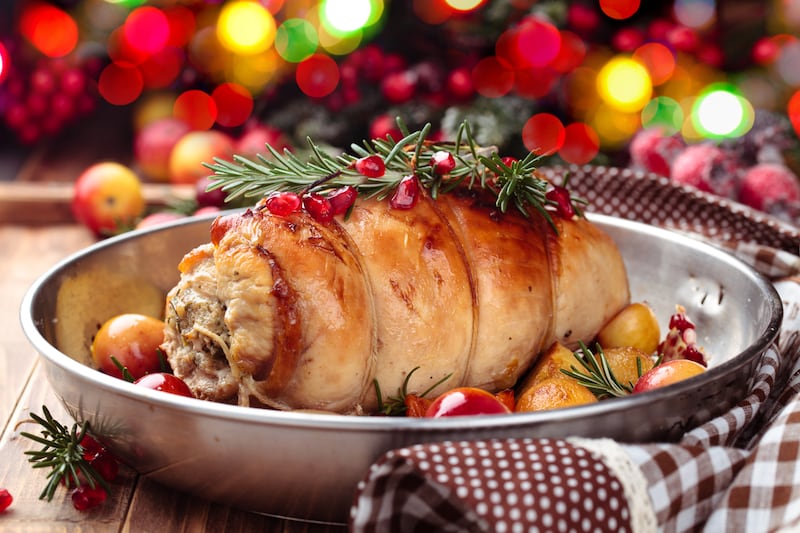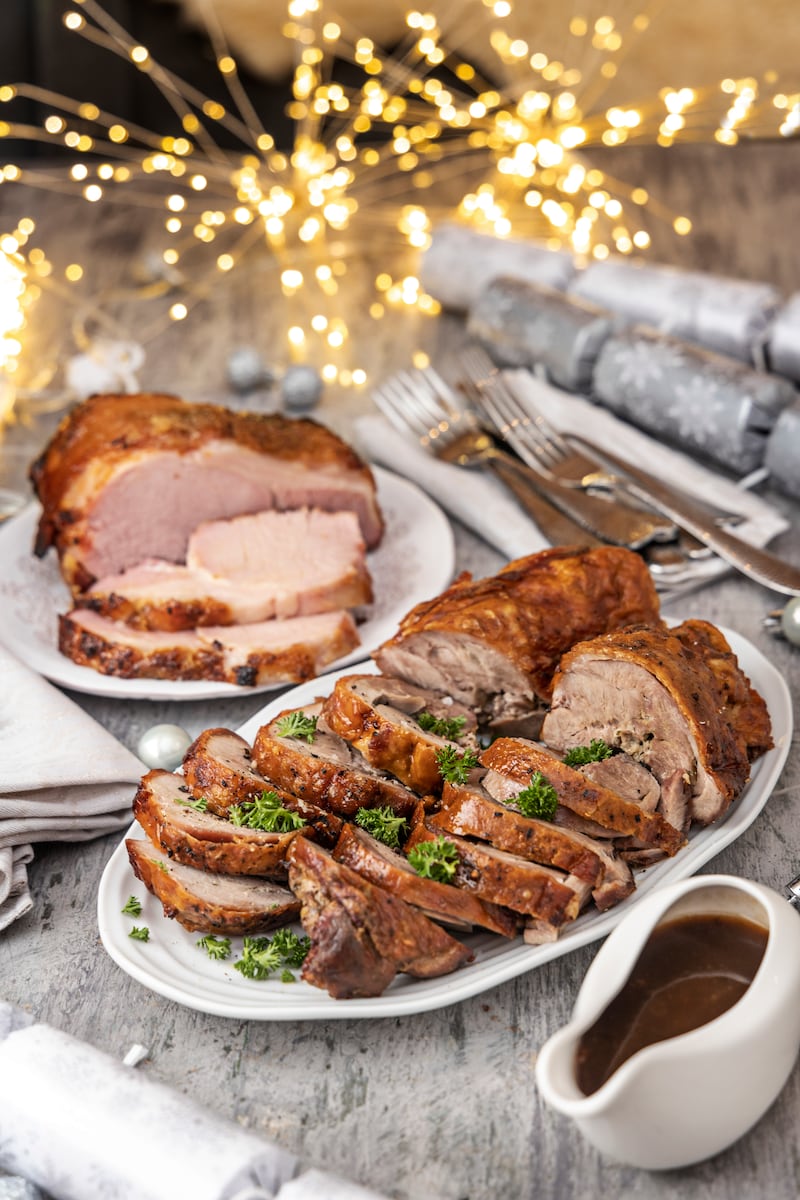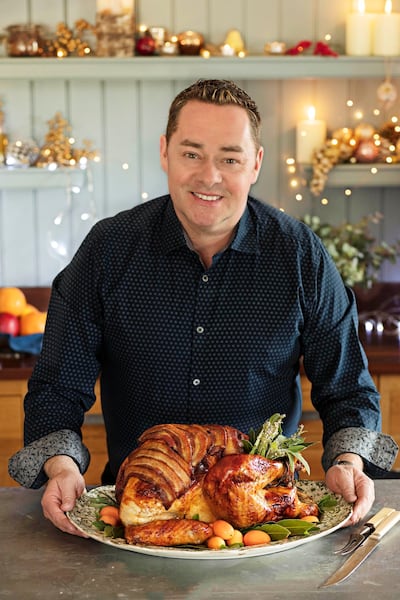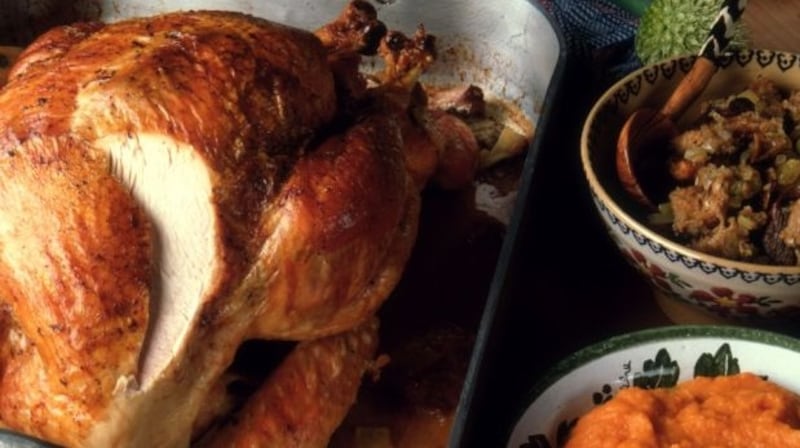Despite rumours to the contrary earlier in the year, turkeys are expected to be in plentiful supply this week when those of us intending to have a one as a centrepiece to the feasting table on the 25th, hit the shops in search of a big bird.
Every year, those on turkey duty hope that their bird will be juicy and flavoursome, rather than dry and insipid, once roasted. "Think of it like a big chicken." Those words of wisdom, attributed to chef and restaurateur Neven Maguire, have calmed the nerves of many a Christmas cook.
But before you even begin to think of how and how long to cook it, you’ll have to make sure to get your hands on a good quality bird. Bronze (which refers to the breed of turkey), organic (reared on organic feed), and free-range (must have access to the outdoors for at least half of its life), are all indications of quality.
What size turkey should I buy?
The size of bird you buy depends on how many people you are feeding, and whether or not you want leftovers (of course you do!). James Whelan Butchers has devised an easy ready-reckoner which goes like this:
- 5-6kg bird will feed 6-7 adults
- 6/7kg = 7-8 adults
- 7/8kg = 8-9 adults
- 8/9kg = 9-10 adults
- 9/10kg = 10-11 adults

Another consideration is whether or not you want a whole bird, a crown, or boned and rolled. This year, many of us will be catering for smaller numbers, and may not want the whole bird.
Getting a butcher to remove the legs (he or she will also be able to bone them out so you can stuff them, and ask them to remove the tendons while they're doing it) means you’ll have brown meat for those who prefer it.
A crown is more easy to manoeuvre in a domestic oven, while a boned and rolled joint is easiest of all and takes the hassle out of carving.
How do I store my turkey?
Most of the supermarkets will have fresh turkeys in stock from December 20th, but if you want to get the pick of the flock on that date, make sure you have copious fridge or freezer space in which to store it. It is worth noting that Safe Food recommends keeping a fresh turkey in the fridge for no longer than two days.
However if you are going to dry brine your bird, like US vice-president-elect Kamala Harris, you will need to have it in the fridge for three or four days, according to food writer and Irish Times Magazine columnist Russ Parsons.
If you are defrosting a frozen turkey, it is best to do so in the fridge, allowing 24 hours for every 2-2.5kg.
How long do I roast it for?
When it comes to roasting the turkey, it should be at room temperature before you put it in the pre-heated oven. Suggested cooking times vary. As John McKenna points out, writing in the Irish Times, not even the experts agree entirely on this.
"Mary Berry says four hours and 10 minutes is needed to cook a 12-14lb turkey, at 200 degrees Celsius. Neven Maguire says you will need 20 minutes per pound for a 12lb bird at 190 degrees Celsius, plus 20 minutes, which is even longer than Mary Berry's timing.
"Darina Allen, then, knocks an entire hour off Neven's estimation, reckoning the 12lb bird is done in three hours. Jamie Oliver agrees with Darina, and both roast at 180 degrees Celsius."
Inserting a skewer into the thickest part of the thigh and checking that the juices run clear, not pink, is the way most cooks check that their bird is done. But, as McKenna recommends, buying a meat thermometer and checking that the meat has reached 70 degrees Celsius, will take all the guesswork out of the equation.
How do I avoid ending up with a dry roasted turkey?
Smothering the breasts with softened butter, or draping them in butter-soaked muslin, will reduce the chances of ending up with a dry bird, a heinous Christmas crime. Likewise, strips of streaky bacon placed across the breasts, in a lattice arrangement if you can bear the faff, will protect the white meat. Regular basting of the bird with the roasting juices will help the skin turn crisp and golden, and the aromas will get appetites going, no matter how much chocolate has been downed.
There is also a camp that believes that the key to a moist turkey is to roast it in a bag. It seems that not everyone wants to spend Christmas morning anointing a bird, and roast-in-the-bag is an area where the supermarkets are seeing growth.
Why should I let the turkey 'rest' before I carve it. Can you explain that?
Letting the turkey rest before you carve will make a massive difference to the end result. It allows for the juices to settle before carving, which should mean more moist and tender turkey. As an added bonus, it will free up your oven to finish cooking other things. As a guide, allow a minimum of 30 minutes resting time, though a whole turkey will stay warm, covered in tinfoil, for around two hours.
What size ham should I buy?
If you plan on cooking a ham, do so on December 24th, to free up your oven, and reduce your workload on the big day. It will improve from an overnight rest, and will carve more easily into thin slices.
Buy a big one – think of the sandwiches – and don't be tempted to skip the glazing step, it just won't be the same without its sugary, clove scented topping. According to turkey-hating chef Paul Flynn, a good ham is the only thing that makes the bird bearable.
We won’t go that far, but it wouldn’t be the same without one, would it?
James Whelan Butchers does a whole heritage cure ham, bone in, for amazing soup, (from €39.99). It has smoky hickory notes, and is low in salt. Cook it low and slow in the oven, no boiling required.
If you prefer to boil a ham then glaze it in the oven afterwards, you should cover the ham with cold water, bring it to a gentle boil, then simmer it for 20 minutes per 500g. Once it is cooked, remove the ham from the water and allow it to cool. Cut the skin off, leaving a thin layer of the fat, which you can score in a cross-cross pattern with a sharp knife and stud with whole cloves. Brush the ham generously with your choice of glaze and put it in an oven heated to 180 degrees Celsius for 15-20 minutes, basting with the glaze occasionally.
Grainne O’Keefe’s stuffed turkey leg

Not everyone has need of a full bird, and this is where crowns, or legs, come into their own. Our recipe columnist Grainne O’Keefe has simplified the entire Christmas main course by serving boned and stuffed legs alongside a ham. This is an economical alternative to purchasing a whole bird. She makes a rich turkey gravy with the bones from the legs, and her miso roast potatoes are a touch of genius. Her recipe for the complete main course is here.
Paul Flynn’s cider roasted turkey

Serves six
Ingredients
1 turkey, 5-6 kg
4 onions, peeled and sliced into thick slices
1 packet smoked bacon lardons
2 generous springs fresh sage or thyme
2 x 440 ml cans cider
2 sticks cinnamon or a pinch of powdered cinnamon
250g melted butter
Salt and pepper
Method
1 Pre-heat an oven to 170 degrees Celsius, or equivalent.
2 Remove the neck and giblets from inside the turkey.
3 Trim any excess fat from the opening and stuff the turkey, taking care not to pack it too tightly.
4 Place the onions and smoked bacon lardons on the base of an oven tray, along with the turkey neck, cinnamon and herbs.
5 Perch the turkey on the onions and pour one can of cider around the tray.
6 Brush the turkey liberally with the butter, then season it well.
7 Cover tightly with foil and seal around the edges of the tray.
8 Cook for 2 hours 45 minutes, then remove the turkey from the oven.
9 Turn the heat up to 185 degrees Celsius.
10 Remove the foil and add the other can of cider and place in the oven for another half hour.
11 Baste the turkey with the buttery juices in the tray a few times in this last phase as it will give a lovely golden sheen to the bird.
12 When cooked, transfer the turkey to another tray, cover it loosely in foil and allow it to rest.
13 Strain the juices into a pot. Let it settle. Any fat will rise to the top. Ladle this off.
14 Reduce the juice (by bringing to the boil) by one third. This is your gravy.
Neven Maguire’s Tips for a stress-free Christmas, and a tender, moist turkey
Shop ahead If you are wondering how early you can pick up the turkey, they should be bought on or after December 22nd. Ideally you should order your turkey well in advance, then the right size will be waiting for you at the supermarket or butcher until you need to collect it.

What type of turkey to buy I prefer to use a free-range or organic bird for this special occasion. Work out the size you need or ask your butcher for advice on this. Make sure they weigh it for you so that you can easily work out how long to cook it for. When you get home, remove the turkey from the packaging and remove the giblets – it's best to make the stock the day you pick it up. Put the turkey on a tray and cover with greaseproof paper. Store in the bottom of the fridge.
Cooking for one: turkey breast If you are only cooking for yourself and would like some leftovers, or for just two people, a single turkey breast is a good option. If you have the time and inclination it would benefit from soaking in a buttermilk brine for a more tender and moist texture, but it's not essential. Ask your butcher for a 350g (12oz) turkey breast and heat a sauté pan over a low heat. Add 25g (1oz) of butter, and when it's foaming, add the turkey breast, turning it in the butter, but don't allow it to colour. Cover with a round of parchment paper and the lid. Cook for 5-7 minutes, until just cooked through and tender. Carve into thin slices and arrange slightly overlapping on a plate to serve.
Turkey cooking chart I always preheat the oven to 190 degrees Celsius (gas mark 5). Make sure your turkey has been allowed to come back to room temperature. If you have stuffed it you will need to weigh the stuffing and add that amount to your turkey weight. Allow 20 minutes per 450g (1lb) plus 20 minutes extra.
- 1.8kg (4lb) turkey crown (off the bone) will take 1 hour 40 minutes
- 2kg (4½lb) turkey crown (off the bone) will take 1 hour 50 minutes
- 4.5kg (10lb) oven-ready turkey will take 3 hours 40 minutes
- 5.4kg (12lb) oven-ready turkey will take 4 hours
Is the turkey cooked? Ovens can vary, especially when you are cooking other things at the same time and opening the door regularly. Work out the approximate time to cook your turkey, but it's essential to test that it's done, ideally with a meat thermometer or skewer. Insert the dial/spike type of thermometer into the thickest part of the thigh at the beginning of cooking or use a digital meat thermometer or a skewer to check the temperature at the end of cooking.
I always cook mine to 75-80 degrees Celsius rather than the 90 degrees Celsius often suggested on some thermometer gauges. To test whether the turkey is cooked with a skewer, insert it into the thickest part of the thigh and check the juices – they should run clear. If the juices are still pink, then the turkey is not yet cooked. Put it back in the oven, checking it every 10 minutes, and cover your vegetable sides with foil. When the turkey is ready to carve, simply reheat the veg - microwave any that are steamed or boiled and pop the roasted vegetables in a high oven for five minutes.
Resting the turkey You should leave a turkey to rest for about 30 minutes, although a whole turkey will sit for up to two hours if you get terribly behind or someone is delayed. Lift it out of the roasting tin with the help of the foil and put it on a platter. Cover loosely with foil and a clean tea towel. This allows the juices to settle back into the meat, leaving it deliciously moist and easier to carve.
Carving made easy For neat slices, make sure your carving knife is sharp. No carving knife? Use a long, thin-bladed knife or electric carving knife instead. Don't use a serrated knife, as this will rip the meat.
Once the turkey has rested, transfer it to a large board. Hold one of the legs by the knuckle between the leg and body (the hip joint), pulling the leg away from the body as you go. The leg should come away quite easily. Repeat with the other leg and then either carve each leg between the thigh and the drumstick to create two pieces or slice the meat straight off the legs.
Discard the bones or freeze for later to use in stock.
To carve the breast meat, the traditional method is to hold your knife flat against the breast, securing the bird with a carving fork, and cut the meat along the length of the breast.
The other option is to cut the entire breast off the carcass by slicing down one side of the entire backbone, then cutting under the breast, following the line of the ribcage. Then just slice the breast on the board and repeat with the other side.
Hot Christmas dinner Warm the plates in a low oven (the microwave or even the dishwasher works too) and put the turkey and ham on the plates first, followed by stuffing and any garnishes. Finish with the vegetables and roast potatoes. Alternatively, create a buffet area and allow everyone to help themselves, perhaps getting parents to help any children with their selections first.
Extracted from Neven Maguire’s Perfect Irish Christmas, published by Gill Books
Darina Allen: how to cook turkey
For some, Darina Allen is the ultimate authority on how to cook a turkey, and she does make simple work of it. Here is her recipe for classic roast turkey with gravy, which she says is her favourite roast stuffed turkey recipe. “Even after all these years, this buttery fresh herb stuffing is still my absolute favourite.”

Ingredients
1 x 4.5-5.4kg (10-12lbs) free-range organic turkey with neck and giblets
Fresh herb stuffing
350g (12oz) chopped onions
175g (6oz) butter
400-500g (14-18oz) approximately soft breadcrumbs made from good bread (check that the bread is non-GM)
50g (2oz) freshly chopped herbs, eg. parsley, thyme, chives, marjoram, savory, lemon balm
Salt and pepper
For the turkey stock
Neck, gizzard, heart, wishbone and wing tips of turkey
2 carrots, sliced
2 onions, sliced
1 stalk of celery
Green part of a couple of leeks (if available)
Bouquet garni
3 or 4 peppercorns
For basting turkey
(8oz) butter
Large square of muslin (optional)
Method
1. Remove the wishbone from the neck end of the turkey, for ease of carving later. Using a tall narrow saucepan, make a turkey stock by covering the neck, gizzard, heart, wishbone, wing tips, vegetables, bouquet garni and peppercorns with cold water. Bring to the boil and simmer while the turkey is being prepared and cooked, three hours approx.
2. To make the fresh herd stuffing, sweat the onions gently in the butter until soft, for about ten minutes, on a low heat, then stir in the crumbs, herbs and a little salt and pepper to taste. Allow it to get quite cold.
3. Season the cavity of the bird and stuff with three-quarters of the cold stuffing. Put the remainder of the stuffing into the crop at the neck end, or you may decide to do a different stuffing. Either way, tuck the remaining neck flap underneath the bird and secure with the wing tips.
4. Preheat the oven to 180C /350F/ Gas Mark 4. Weigh the turkey and calculate the cooking time. Allow about 15 mins per 450g (11lb) and 15 mins over. Melt the butter for basting the turkey and soak a large piece of good-quality muslin and roast the turkey in the preheated moderate over for 2¼ to 3¼ hours. There is no need to baste it because of the butter soaked muslin. The turkey browns beautifully, but if you like it even browner, remove the muslin 10 minutes before the end of cooking time. Alternatively smear the breast, legs and crop well with soft butter, and season well with salt and freshly ground pepper. If the turkey is not covered with the butter-soaked muslin, then it is a good idea to cover the whole dish with a large sheet of parchment. However, your turkey will then be semi-steamed, not roasted in the traditional sense. The turkey is cooked when the thigh juices run clear. To test prick the thickest part at the base of the thigh and examine the juices: they should be clear.
5. Remove the turkey to a carving dish, keep it warm and allow it to rest while you make the gravy.
6. To make the gravy, spoon the surplus fat from the roasting pan. Deglaze the pan juices with fat-free stock from the giblets and bones. Using a whisk, stir and scrape well to dissolve the caramelised juices from the roasting pan. Boil it up well and season (thicken with a little roux if you like). Taste and correct the seasoning. Serve it a hot gravy boat. If possible, surrounded by crispy roast potatoes and garnished with large sprigs of parsley or watercress and maybe a sprig of holly. Make sure no one eats the berries. Serve with cranberry sauce, bread sauce and gravy.










